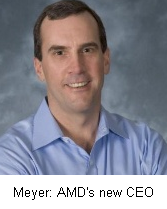Asset smart? AMD moves manufacturing off its balance sheet; Bolsters capital

AMD said Tuesday that it will split off its manufacturing operations in a deal with the Advanced Technology Investment Company of Abu Dhabi. AMD will also receive a capital infusion from Mubadala Development Company, which will wind up owning more than 19 percent of Intel's smaller rival.
When the dealing is done in early 2009, AMD will become a chip design firm and its former manufacturing operations will be lumped into an entity called "The Foundry Company," a temporary name (AMD statement, presentation, Techmeme). AMD's liquidity was hampered by expensive manufacturing operations. AMD's move to separate its manufacturing and design units--dubbed Asset Smart--has been on the drawing board for a while and details have been hard to come by.
The Foundry Company, which will be led by Doug Grose, senior vice president at AMD, will start out making chips based on AMD's designs. AMD will own 44.4 percent of the Foundry Company with Advanced Technology Investment Company (ATIC) owning the rest. The deal is quite a feat of financial engineering, but a good move overall.
In a statement, AMD CEO Dirk Meyer (right), who took over in July, said the
There are multiple moving parts here, but AMD had little choice but to cut a deal now. AMD is mired in a bruising battle with Intel, which has manufacturing scale and a strong roadmap. And capital constraints--as well as a series of disappointing quarters--have hampered AMD, which for now is a no-show in growing markets for mobile Internet devices. Simply put, AMD couldn't afford the manufacturing arms race when it is expected to report a loss of 40 cents a share in the third quarter. AMD ended the second quarter with $1.57 billion in cash and equivalents compared to Intel's $4 billion (the chip giant pays a dividend and has another $4 billion in short-term investments).
John Morris:AMD finally announces "asset-smart" plan; new Foundry Company created
Adrian Kingsley-Hughes:Can two AMDs be better than one?
This slide sums up AMD's rationale:For AMD, the deal means it can remove its manufacturing operations from its balance sheet while allowing the company to still have a lot of control over the new entity. The Foundry Company's results will still be consolidated with AMD's. Meanwhile, AMD and ATIC will split equally the manufacturing company's board and voting rights. The Foundry Company will "have an exclusive supply agreement with limited exceptions to manufacture AMD processors" with the option for other chips.
On a conference call, Grose said The Foundry Company will follow through on AMD's plans to build a fab in upstate New York in 2009 and complete a buildout of AMD's Dresden fabrication plant. If the market warrants it, Grose said, The Foundry Group will "consider research and manufacturing operations in Abu Dhabi." That comment partially explains ATIC's investment. Abu Dhabi has been aggressively diversifying its economy away from oil with investments in financial services, tourism and what could be technology via The Foundry Company. Abu Dhabi is also funding a campus for New York University.
What's unclear is whether AMD can maintain pace with Intel on higher-end semiconductors without its manufacturing operations. UBS analyst Uche Orji notes:
We believe that even as a possible separation of AMD's fabs reduces its ability to be competitive with Intel’s high-end, it could allow AMD to focus on designing cost-effective PC platforms for mainstream computing. We expect AMD to realize processor selling price stability through new products and margin expansion by designing lower-cost, smaller die size processors at 45nm and below. AMD’s expected 4Q launch of its first 45nm processor, Shanghai, is a key milestone.
Also see: AMD slims down, sells digital TV business to Broadcom
Among the financial details:
- Existing shareholders will be diluted by the Mubadala investment. Mubadala, which will own 19.4 percent of AMD up from 8.1 percent today, buys 58 million new AMD shares for $314 million with warrants to buy another 30 million. Mubadala will have a representative on AMD's board of directors.
- However, AMD's liquidity improves. AMD unloads $1.2 billion in debt to The Foundry Company and gets the $314 million infusion from Mubadala. ATIC will pay AMD $700 million for its stake in The Foundry Company. The upshot AMD comes out of this with more than $1 billion in cash while reducing its debt. Add it up and AMD gets a liquidity swing of $2.1 billion.
- The Foundry Company will have an enterprise value of $5 billion, the estimated sum of AMD's manufacturing plants--such as its prized Dresden fab, intellectual capital and employees ($2.4 billion), $1.4 billion in new capital from ATIC and $1.2 billion in debt. ATIC and AMD will be the only shareholders of The Foundry Company, which will be based in Silicon Valley and have hubs in New York, Dresden and Austin.
And the recap:
The larger question is whether The Foundry Company has a bright future ahead. In its presentation, AMD said noted that many chip outfits are outsourcing manufacturing. AMD also noted that The Foundry Company will be in IBM's technology alliance and inherit its manufacturing prowess. AMD named The Foundry Company's peers as TSMC, UMC and Chartered Semiconductor. Will The Foundry Company be so tethered to AMD that it can't lure new customers?
And here's how AMD stacks up the benefits of the deals today:
For the most part, I'd agree with AMD's take of benefits. Clearly the biggest benefit is that AMD's moves take the question of insolvency off the table. I'm not sold yet on the upside potential of The Foundry Company, but time will tell.